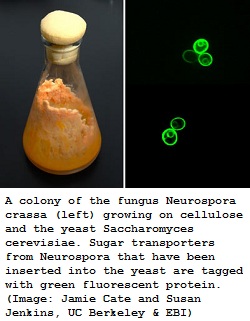 Researchers at the University of California, Berkeley have made a breakthrough that has some awfully big implications for cellulosic ethanol.
Researchers at the University of California, Berkeley have made a breakthrough that has some awfully big implications for cellulosic ethanol.
They’ve been able to put genes from grass-eating fungi into yeast and created strains that produce alcohol from tough plant material:
“By adding these genes to yeast, we have created strains that grow better on plant material than does wild yeast, which eats only glucose or sucrose,” said Jamie Cate, UC Berkeley associate professor of molecular and cell biology and faculty scientist at Lawrence Berkeley National Laboratory (LBNL). “This improvement over the wild organism is a proof-of-principle that allows us to take the technology to the next level, with the goal of engineering yeast that can digest and ferment plant material in one pot.”
The researchers hope to insert the same fungal genes into industrial strains of yeast that now are used to turn sugar into ethanol biofuel in order to improve the efficiency of the fermentation process.
“The use of these cellodextrin transporters is not limited to yeast that makes ethanol,” Cate said. “They could be used in any yeast that’s been engineered to make, for example, other alcohols or jet fuel substitutes.”
The research has been funded by the Energy Biosciences Institute (EBI), a research collaboration between UC Berkeley, the University of Illinois, LBNL and the funding sponsor, BP.

